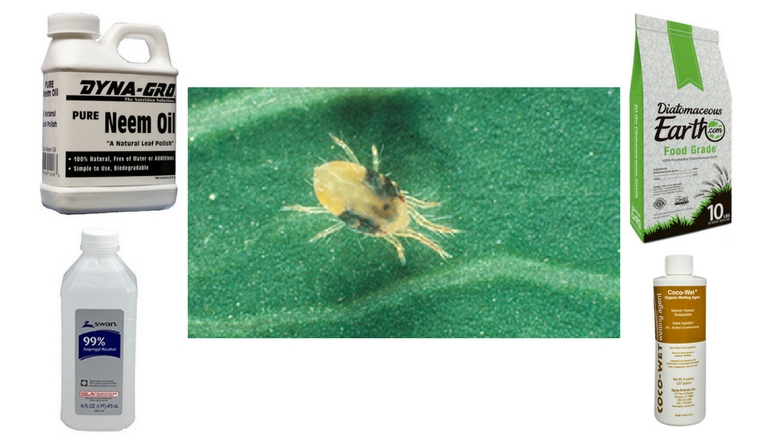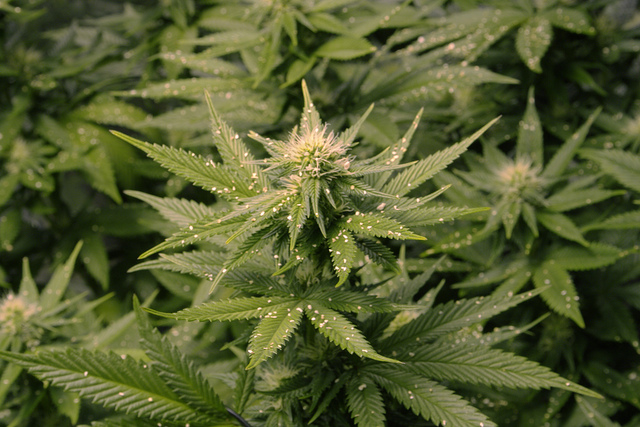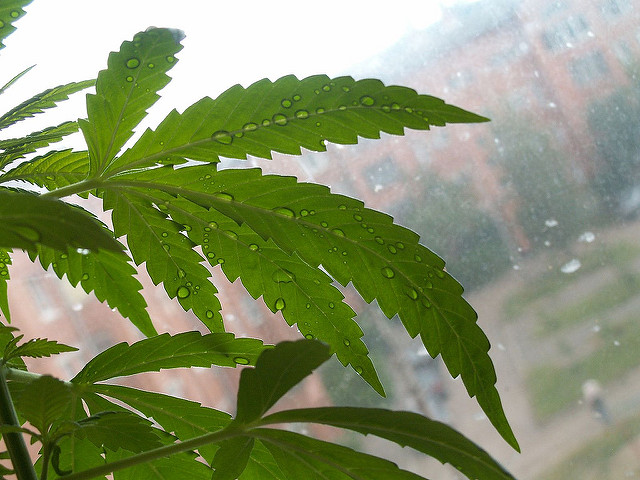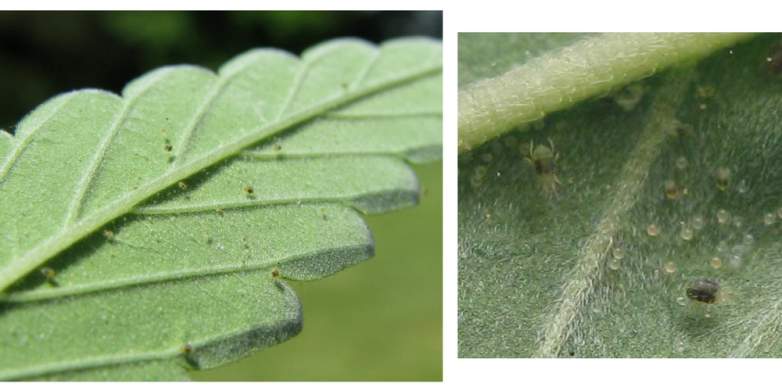
Pests and infestations are one of the most common problems that new as well as ex[erienced growers face. Whether you are in your vegetable garden or your cannabis grow room, you are going to come across pests at some point in your growing experience. For marijuana growers, spider mites on cannabis are one of the most common and most problematic pests that infect our plants.
Pests and other problems most commonly occur during vegetative growth, and your plants may be more or less susceptible to infestation based on how carefully you manage their environment and fertilization. In this article I am going to go over ways to reduce your risk of pests and other issues, as well as what to do once you notice that an infestation has occurred. I’ll focus mostly on spider mites because they are such a universal problem for cannabis growers, but many of the techniques and tips listed below can be applied to other pest problems as well.
What Are Spider Mites?
Spider mites are a type of insect within the mite family, are related to spiders and ticks, and are considered arachnids instead of insects. Spider mites have eight legs, no antennae and are extremely small. They are impossible to see with the naked eye, so you need to have a magnifier in order to see for sure if your cannabis is infested. They are called spider mites not only because of their eight legs, but because they spin tiny, silky webs on your cannabis plants’ leaves as a way of protecting themselves and their eggs from predators. There are different types of spider mites but prevention and eradication measures are basically the same for all types.
Spider mite infestations often occur quickly and ruthlessly. Once you spot the signs of infestation, it is likely that thousands if not millions of eggs have already been laid. Eggs hatch in three days, and within five days they have reached maturity and start breeding again. Infestation can go from barely noticeable to devastating in a very short period of time.
Spider mites are most common on outdoor or soil grown plants. What causes spider mites? The dead organic matter in soil is the perfect breeding ground for mites, and cannabis plants grown in close range to each other can spread the infestation incredibly rapidly. If you do not act fast, your entire crop could be ruined within a few short weeks.
Spider mites feed on chlorophyll, the substance that turns leaves green, which is required for photosynthesis. The mites use their tiny teeth to bite into individual plant cells and suck out the chlorophyll. You can imagine how on a large scale this could be devastating to your crop. Without proper levels of chlorophyll, plants are not able to perform photosynthesis and they will be starved of nutrients and will eventually die. At the very least, a bad infestation will greatly impact your cannabis plants’ ability to form large buds.
How To Spot Problems And Pests
The key to eradicating spider mites is early detection. The most important piece of advice that an experienced grower can give you is to watch your plants closely on a daily basis and look out for signs of anything unusual. The leaves should be properly formed, straight, and flat. They should have an even green color and their growth should be steady and adhere to the phenotype of your particular strain. For example, indica strains are typically more short and bushy than sativa, so if you notice your indica plants becoming too tall and lanky you may have an issue on your hands.
Problems like nutrient deficiency, mildew, bad lighting, too warm or too cold temperature, and improper humidity levels can make your plants vulnerable to pests like spider mites. The best way to prevent infestation is to make sure that you have strong, hardy plants right from the start. The only way to do this is to make sure you have all of the materials and the knowledge you need to provide the proper environment and nutrients for your plants for their entire life cycle.
Spider mites are microscopic in size and very hard to spot with the naked eye until the infestation is pretty large. If you do leaf inspections with a magnifier every day, you are much more likely to catch it early. Some of the first signs you will be able to see without a magnifier are small white spots on the tops of the leaves. This happens due to the loss of chlorophyll on the under side of the leaf as the mites eat through the plant cells. Next you will notice small silky webs everywhere on your plant. By the time you start to see webs, you need to take immediate action to save your plants.
How To Prevent Spider Mites
As we learned above, prevention is your best weapon when dealing with spider mites. They are so common and so detrimental that you are better off assuming that they are present and treating your plants with preventative measures from the beginning. The first thing you can do is to add fresh organic compost and mulch to your soil-grown cannabis plants. This introduces beneficial predatory mites that can eat up any spider mites before they take hold and create a colony.
Ladybugs and predatory mites are also a huge benefit to cannabis growers. Ladybugs love to eat spider mites, and can prevent small infestations from getting out of hand. You can purchase ladybugs and other predatory mites online by the thousands, and they can be used both indoors and outdoors. If you use them outdoors, make sure to release them at dusk so that they do not immediately fly away. They will get settled in overnight and start feasting in the morning.
Another simple preventative and treatment measure you can take is to regularly spray your leaves with water. Whether you grow outside and spray with a fine mist sprayer on your hose, or indoors with a spray bottle, keeping the leaves wet on the upper and lower sides can help prevent infestation. Spider mites prefer a dusty, dry environment so if the infestation is small, moist leaves will encourage them to move on. You do need to make sure you don’t over-water your plants. A fine mist hose nozzle or spray bottle is your best tool to concentrate the spray on the leaves only.
Garlic is another effective deterrent for spider mites and other pests. To make a garlic solution, you can either soak whole garlic cloves in water for a few days, or blend them and strain it through a fine mesh sprayer. Monthly treatment with this spray can be a great way to keep your cannabis plants free of pests. It can even help to treat a spider mite infestation while it is small.
Getting Rid Of A Spider Mite Infestation
If you notice a well established spider mite colony on your cannabis plants, or you have a very large grow op with a mite problem, the chances of saving your plants are unfortunately not very good unless you take quick and decisive action. You may need to take extreme measures, and chances are it will be either time consuming or expensive. Here is a list of some of your “nuclear options” for attempting to save your plants from a large spider mite infestation:
- Neem oil is a natural and effective treatment for spider mites and other pests. Neem oil reduces insect feeding and interferes with their hormone systems, stunting their growth and reproduction. Neem oil must be used on a strict schedule in order to be effective.
First, make a solution of 1 gallon water to 2 Tbs Neem oil and 1/2 tsp Coco Wet wetting agent. Spray your plants thoroughly for seven treatments on the following schedule – Three days in between treatments for the first three, five days in between treatments for the last four. - A hard water spray can be effective at knocking mites off of your leaves and loosening the eggs. One treatment is not enough, so repeat as necessary until you notice the infestation getting better. This treatment can be rough on your plants so I only recommend it as a last resort.
- You can also vaccuum your plants and leaves to remove mites and their eggs. Use a small-mouthed vacuum hose and be very gentle, as you can easily damage tha plants themselves.
- A more gentle approach is to run your fingers over each individual leaf in order to rub off mites and eggs. This treatment may need to be repeated a few times. As you can imagine this is very time consuming, but it is effective. This is really only practical for small grow ops.
- An alcohol solution of at least 30% isopropyl alcohol can also help control infestation. Just like with Neem oil, you will need to use and 1/2 tsp Coco Wet wetting agent per each gallon of solution. You can either spray your plants or rub each leaf with a soaked cotton ball. This treatment is most effective when done daily until mites are gone.
- Diatomaceous Earth is a natural insecticidal product that is made of fossilized remains of microscopic sea creatures. It is a fine powder and can be sprinkled on the plants to form a white coat. Diatomaceous Earth works because it has sharp microscopic edges on its particles, which slice through the protective layer on mites outer shell and causes them to dehydrate.
See Also:




